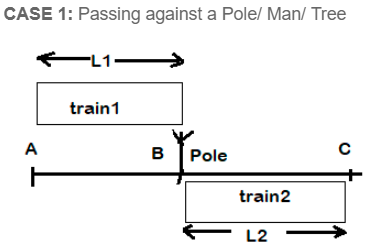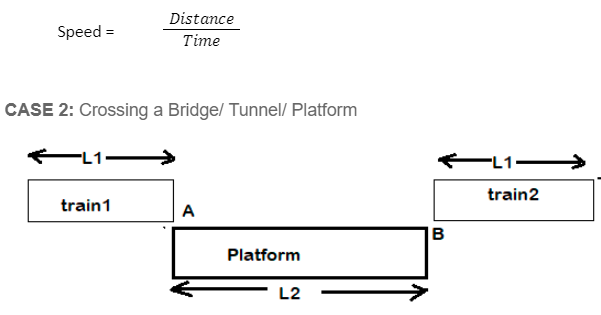Train problem is a quantitative aptitude problem related to speed, time, and distance.
Major Concepts of Problems on Trains
The concepts of train problem can be divided into four parts:
- Conversion
- Time and Distance formula
- Train and Object
- Theory of Relativity
Conversion
The questions ask to convert the speed of the train from,

We do this because 1 km = 1000 m and 1 hr = 3600 seconds.
Which means conversion, in this case, should be 1000/3600 = 5/18, when simplified.

Tricks and Tips
- We may get confused about what to multiply for a given question. While knowing where the numbers come from helps, we have some other tips to remember
- To simplify, remember: when converting to smaller (km → m), the numerator should be smaller than the denominator. Hence, 5/18
- Similarly, when converting to bigger (m → km), the denominator should be smaller than the numerator. Hence, 18/5
Example 1: Convert 24km/h to m/s.
Soln:
We know that

Hence, we get 24x(5/18)=6.66m/s.
Time and Distance Formula
This type of problem is based on the concept of speed. Speed is defined as distance travelled per unit of time.

Tricks and Tips:
- Write down the data which is available
- Remember the formula that Speed = Distance/Time
- Any two out of the three will be given. We will be required to find the third measure
- It is important to know the units of all three
- Ensure that all the units are the same while calculating. For example: if speed is given in m/s and distance in km, it is important to convert the distance into m
Example 2: A train is travelling 200 m and runs at a speed of 50 m/s. How much time will be required to cover the distance?
Soln:
With the given available date we can say that,
- Speed = 50 m/s
- Distance = 200 m
We know the formula that,
Speed = Distance/Time
Therefore, 50 = 200/t
t = 200/50 = 4 s
Hence, the train will cover the given distance in 4 seconds.
Train and Object
This subsection consists of two cases.

- The train will pass the pole completely when the back of train 1 will come at point C
- The required formula is

- When the back end of the train passes point B, the train will have completely crossed the platform
So, the distance travelled by the train is L1 + L2. .The formula, then, is:

Example 3: A train is 300 m long and is running at a speed of 54km/hr. How much time does it take to pass a bridge, which is 100 m long?
Soln:
We first write the given data,
- Train length = L1 = 300 m
- Bridge length = L2 = 100 m
- Speed = S = 54 km/hr
Converting 54 x (5/18)= 15 m/s

Hence, the time required to pass the bridge is 26.66 seconds.
Example 4: A train covers a distance of 10 km in 10 minutes. If it takes 6 seconds to pass a telegraph pole, then what is the length of the train?
Soln:
We are given that the train covers 10 km distance in 10 minutes.
Speed = Distance/Time
Converting 10 min = 10 x 60 = 600 s
Now, distance = 10 x 1000 = 10,000 m
Applying the above formula we get
Speed = 10,000/600 = 16.66 m/s
Now, it is given that it takes 6 s. To pass the pole,
Distance = Speed x time
Distance = 16.66 x 6 = 99.96 m
Hence, 99.96 (approximately 100 m) is the length of the train.
Theory of Relativity
This subsection has the following two cases.

- In this, we say that the trains have crossed each other completely, when if B and D cross each other.
- So, the lengths L1 and L2 have to be covered.

Example 5: If two trains, 100 m and 200 m long, at speeds of 600 km/h and 30 km/hr, are running in opposite direction, what is the time taken by trains to cross each other?
Soln:
We know that:
Length of train1 = L1 = 100 m
Length of train2 = L2 = 200 m
Speed of train1 = U = 60 km/hr
Speed of train1 = V = 30 km/hr
As they are in opposite directions,
S = U + V = 90 km/hr
Convert 90 km/hr into m/s = 25 m/s
Now, using the formula of CASE 1

Example 6: Two trains of equal length are running parallel in the same direction. Their speeds are 40 km/hr and 30 km/hr. The faster train passes the slower train in 30 seconds. What are their lengths?
Soln:
We know that as they are in the same direction. Hence, we apply CASE 2.
U = 40 km/hr and V = 30 km/hr
U – V = 10 km/hr
Converting 10 km/hr = 2.77 m/s
As lengths are equal L1 = L2 = L.
Hence, applying the formula:

2L = 30 x 2.77
L = (30 x 2.77)/2
L = 41.66 m
Hence, the length of the trains is 41.6 m.
Conclusion
- From conversion from km/hr to m/s, multiply it by 5/18.
- Conversion of m/s to km/hr, multiply by 18/5.
- The general formula for speed is given as Speed = Distance/ Time.
- The train appears to move faster when in the opposite direction then to when in the same direction. This is known as the theory of relativity.
- When the trains are moving in different directions, we add the speed of the trains. When in the same direction, we subtract it.
 Profile
Profile Settings
Settings Refer your friends
Refer your friends Sign out
Sign out






